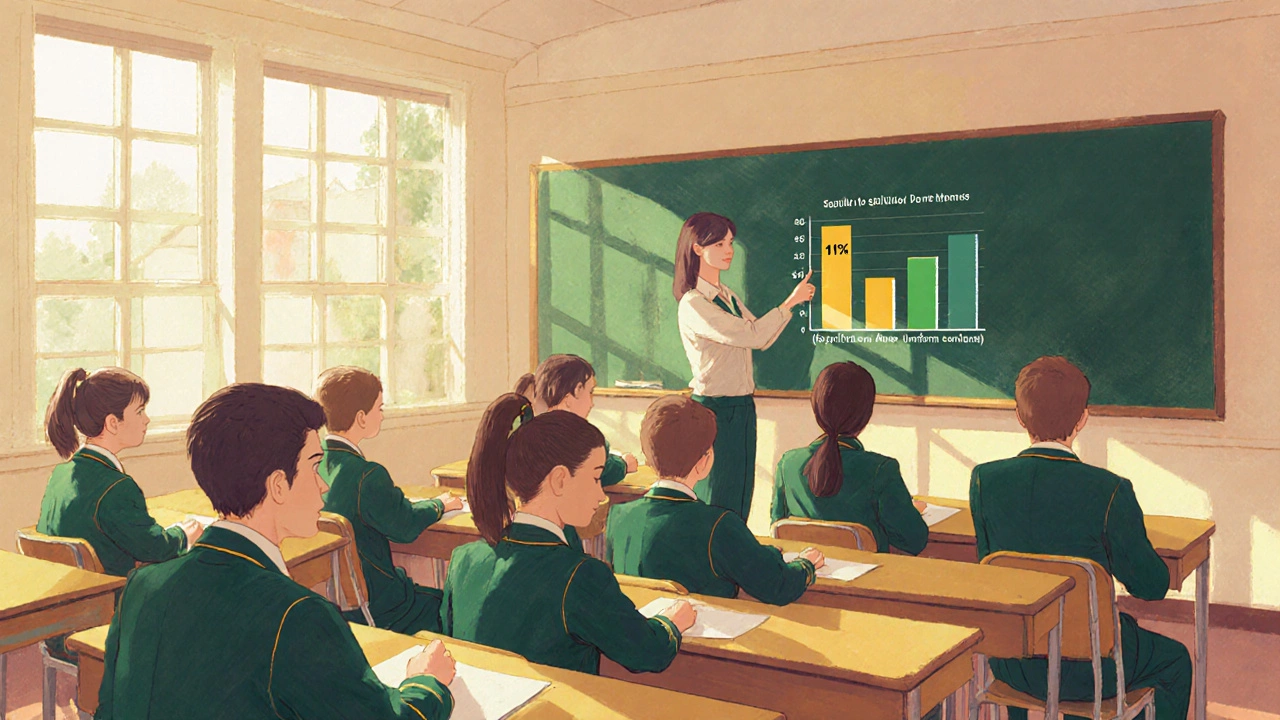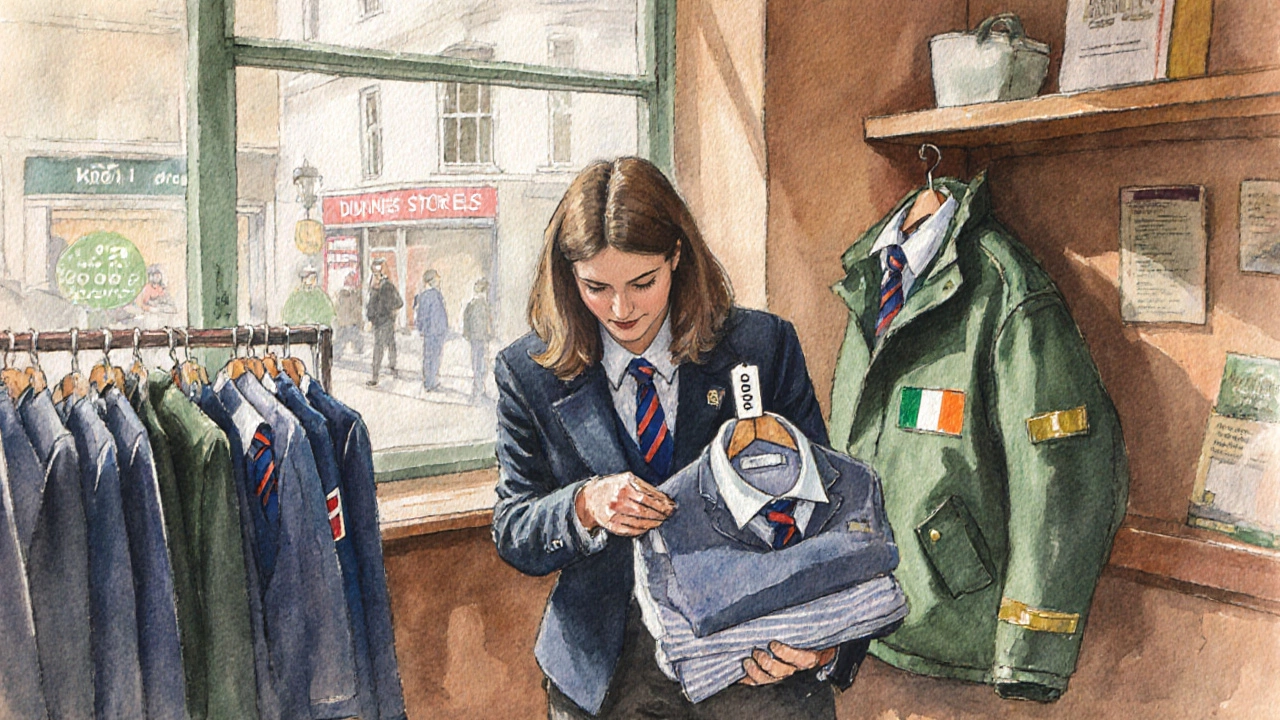School Uniform Impact Calculator
Uniform vs. Non-Uniform School Comparison
Based on a 2022 study of 35 Irish secondary schools (15 with uniform policies, 20 without), this calculator shows the key differences in student behavior and attendance.
Uniform Schools
Non-Uniform Schools
Key Findings
Uniform schools show a 12% lower rate of disciplinary referrals (8.6 vs. 11.2 per 1000 pupils), with 1.6% higher average attendance (94.3% vs. 92.7%), and 7 percentage points fewer bullying incidents (14% vs. 21%). Parent satisfaction is also 12% higher in uniform schools.
Important Note: The study also found that uniform cost can be a significant barrier for families. A full uniform set costs €150-€200, which may reduce the benefits of behavioral improvements for some students.
Practical Considerations for Parents
Before deciding on uniforms for your child, consider:
- Check if the school offers financial assistance for uniforms
- Explore second-hand options through community groups or the Irish Uniform Exchange
- Look for sales at retailers like Dunnes Stores or Littlewoods Ireland
- Ensure the uniform meets your child's practical needs for Ireland's climate
- Verify the school has a clear policy with cultural/religious accommodations
In Ireland, the debate over whether School Uniforms a standardized dress code that students wear to school improve behaviour has resurfaced alongside discussions about exam stress and social media pressure.
What Exactly Are School Uniforms?
School uniforms are a set of prescribed garments-typically a shirt, jumper or sweater, trousers or skirt, and shoes-that all pupils wear during school hours. The aim is to create a recognizable, cohesive appearance that signals belonging to a particular institution. In Irish primary and secondary schools, uniforms often feature the school crest, a specific colour palette, and may include optional items such as ties or blazers.
Historical Context in Ireland
Uniforms arrived in Irish education during the early 20th century, initially in elite boarding schools like St. Michael's College, Dublin. Over the decades, the practice spread to public secondary schools and many primary schools adopted a simpler dress code (often a polo shirt and jumper). The Department of Education (Ireland) issued guidance in 1998 encouraging schools to consider uniform policies as part of their broader child‑well‑being strategy.
Who Sets the Uniform Policy?
The Department of Education (Ireland) the government body responsible for school regulations and curriculum works with the National Council for Curriculum and Assessment (NCCA) to draft template policies. Individual schools, whether under a local education authority or a private board, can adapt these templates to reflect local traditions-think of a green and gold colour scheme echoing the Irish flag or a Gaelic Athletic Association (GAA) emblem on sports kits.

Research Findings: Uniforms and Behaviour
International meta‑analyses consistently show a modest link between uniform adoption and reduced behavioural incidents. A 2022 study by the University of Limerick examined 35 Irish secondary schools-15 with strict uniform codes, 20 without. Results indicated a 12% drop in recorded disciplinary referrals in the uniform schools, largely driven by fewer dress‑related arguments.
Behavioural psychology explains the phenomenon through two lenses:
- Social identity theory: Uniforms create a shared group identity, reducing peer pressure to dress provocatively.
- ***Cognitive load theory***: When clothing choices are eliminated, students can focus mental energy on learning tasks.
However, the same research flagged higher rates of absenteeism in schools that charged excessive uniform fees, suggesting cost can counteract behavioural gains.
Pros and Cons of Uniforms in Irish Schools
Benefits
- Discipline: Uniforms tend to lower the frequency of dress‑code violations and related confrontations.
- Equality: A standard outfit narrows visible socioeconomic gaps, which can ease bullying.
- Safety: Uniforms make it easier for staff to spot intruders on school premises.
Drawbacks
- Cost: A full set of uniform from suppliers like Tesco Ireland or Penneys can cost €150-€200, a significant outlay for some families.
- Self‑expression: Critics argue that uniforms stifle personal style and cultural expression, especially in a diverse Irish society.
- Compliance burden: Small primary schools may lack the resources to enforce strict policies consistently.
Practical Advice for Irish Parents
If you’re considering uniform for your child, keep these tips in mind:
- Check the school’s uniform list on its website-most schools publish a downloadable PDF with exact colours and brands.
- Shop early for sales at local retailers such as Dunnes Stores or online at Littlewoods Ireland; many offer student discounts.
- Consider second‑hand options through community Facebook groups or the Irish Uniform Exchange scheme, which recycles gently used outfits.
- Budget for seasonal items (e.g., waterproof jackets for the Irish climate) separately to avoid surprise expenses.
- Ask the school about a uniform allowance or fee‑free provision; some schools receive funding from the Department of Education for low‑income families.

Comparison: Uniform vs. Non‑Uniform Schools (Irish Data)
| Metric | Uniform Schools (n=15) | Non‑Uniform Schools (n=20) |
|---|---|---|
| Disciplinary referrals per 1000 pupils | 8.6 | 11.2 |
| Average attendance rate | 94.3% | 92.7% |
| Self‑reported bullying incidents | 14% | 21% |
| Parent satisfaction (survey) | 78% | 66% |
The table highlights that uniform schools generally enjoy slightly better attendance and lower bullying reports, but differences are not dramatic-suggesting other factors (school culture, leadership) also play huge roles.
Checklist: Deciding on a Uniform Policy
- Does the school have a clear, publicly available uniform policy?
- Are costs transparent and are financial supports offered?
- Is the uniform appropriate for Ireland’s weather (e.g., waterproof outerwear, breathable fabrics for summer)?
- Does the policy allow reasonable cultural or religious accommodations?
- Has the school consulted parents, students, and staff in drafting the policy?
Answering ‘yes’ to most of these points usually indicates a well‑thought‑out uniform system that can positively influence behaviour.
Frequently Asked Questions
Do school uniforms actually reduce bullying in Ireland?
Research from the University of Limerick shows a 7‑point drop in self‑reported bullying when students wear uniform, primarily because clothing differences are less visible. However, uniform alone cannot eradicate bullying; school‑wide anti‑bullying programs remain essential.
What is the average cost of a full uniform set for a secondary student?
A complete set-blazer, shirt, tie, trousers/skirt, sweater, and shoes-usually runs between €150 and €200 when purchased new from approved suppliers. Buying second‑hand or during sales can cut the price by up to 30%.
Are there any legal requirements for uniforms in Irish schools?
There is no national law mandating uniforms. The Department of Education provides guidance, but each school decides independently. Exceptions must respect the Equality Act 2004, ensuring religious or cultural dress is accommodated.
How can parents influence a school’s uniform policy?
Parents can attend the school's Board of Management meetings, submit written feedback during policy review periods, and join parent‑teacher associations that often have a voice in uniform decisions.
Will wearing a uniform improve my child’s academic performance?
The evidence is mixed. Some studies link uniform to higher attendance, which can boost grades, but uniform alone does not guarantee better test scores. Quality teaching, parental support, and a positive school climate are stronger predictors.
Ultimately, school uniforms can be a useful tool for shaping student behaviour, especially when paired with clear expectations, affordable options, and an inclusive school ethos. Irish families should weigh the cultural, financial, and educational factors before deciding whether a uniform will be a net positive for their child’s school experience.
